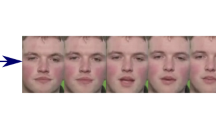Abstract
DECface is a system that facilitates the development of applications requiring a real-time lip-synchronized synthetic face. Based on the X Window System and the audio facilities of DECtalk and AF, DECface has been built with a simple interface protocol to support the development of face-related applications. This paper describes our approach to face synthesis, the face and audio protocol, and some sample code examples.
Similar content being viewed by others
References
C. Browman and L. Goldstein. Dynamic modeling of phonetic structure. In V. Fromkin, editor,Phonetic Linguistics, pages 35–53. Academic Press, New York, 1985.
P. Bergeron and P. Lachapelle. Techniques for animating characters. InAdvanced Computer Animation, volume 2 ofSIGGRAPH '85 Tutorials, pages 61–79. ACM, 1985.
E. Bruckert, M. Minow, and W. Tetschner. Three-tiered software and VLSI aid developmental system to read text aloud.Electronics, 1983.
C.S. Choi, H. Harashima, and T. Takebe. Highly accurate estimation of head motion and facial action informations on knowledge-based image coding. Technical Report PRU90-68, IEICEJ, 1990.
J. Destandes. Histoire comparée du cinéma. Castarman, Paris. 1, 1966.
P. Ekman and W.V. Friesen.Manual for the Facial Action Coding System. Consulting Psychologists Press, Palo Alto CA, 1977.
G. Farin.Curves and Surfaces for Computer Aided Geometric Design. Academic Press Inc., New York, 1990.
V. Fromkin. Lip positions in american english vowels.Language and Speech, 7(3):215–225, 1964.
H. Gouraud. Continuous shading of curved surfaces.IEEE Trans on Computers, 20(6), 1971.
P. Heckbert. Survery of texture mapping.IEEE Computer Graphics and Applications, 6(11):56–67, 1986.
D.R. Hill, A. Pearce, and B. Wyvill. Animating speech: An automated aproach using speech synthesis by rules.The Visual Computer, 3:277–289, 1988.
H.D. Kochanek and R.H. Bartels. Interpolating splines with local tension, continuity and bias control.Computer Graphics, 3(18):33–41, 1982.
Dennis H. Klatt. Software for a cascade/parallel formant synthesizer.J. Acoust. Soc. Am., 67(3):971–995, 1980.
Dennis H. Klatt. Review of text-to-speech conversion for english.J Acoust. Soc. Am., 82(3):737–793, 1987.
S. Kiesler, L. Sproull, and K. Waters. A prisoner's dilemma experiment on cooperation with people and human-like computers.Journal of Personality and Socal Psychology (under revision), 1995.
J.P. Lewis and F.I. Parke. Automatic lip-synch and speech synthesis for character animation. InCHI+CG '87, pages 143–147, Toronto, 1987.
Thomas M. Levergood, Andrew C. Payne, James Gettys, G. Winfield Treese, and Lawrence C. Stewart. AudioFile: A network-transparent system for distributed audio applications. Technical Report 93/8, Digital Equipment Corporation, Cambridge Research Lab, 1993.
Y. Lee, D. Terzopoulos, and K. Waters. Constructing physics-based models of individuals.Proceedings of Graphics Interface'93, pages 1–8, 1993.
M. McGrath.An Examination of Cues for Visual and Audio-Visual Speech Perception using Natural and Computer Generated Faces. PhD thesis, University of Nottingham, England, November 1985.
N. Magnenat-Thalmann, N.E. Primeau, and D. Thalmann. Abstract muscle actions procedures for human face animation.Visual Computer, 3(5):290–297, 1988.
M. Oka, K. Tsutsui, A. Ohba, Y. Kurauchi, and T. Tago. Real-time manipulation of texture-mapped surfaces.Computer Graphics, 21(4):181–188, 1987.
John K. Ousterhout. Tcl: An embeddable command language. InProceedings of the USENIX Winter Conference, January 1990.
John K. Ousterhout. An X11 toolkit based on the Tcl language. InProceedings of the USENIX Winter Conference, January 1991.
F.I. Parke. Computer generated animation of faces. Master's thesis, University of Utah, Salt Lake City, June 1972. UTEC-CSc-72-120.
F.I. Parke. Parameterized models for facial animation.IEEE Computer Graphics and Applications, 2(9):61–68, 1982.
F.I. Parke. State of the art in facial animation.ACM SIGGRAPH Course Notes, 26, 1990.
S.M. Platt and N.I. Badler. Animating facial expressions.Computer Graphics, 15(3):245–252, 1981.
W. Press, B. Flanney, S. Teukolsky, and W. Verttering.Numerical Recipes: The Art of Scientific Computing. Cambridge University Press, Cambridge, 1986.
F. Thomas and O. Johnson.Disney the Illusion of Life. Abbeville Press, New York, 1981.
C.T. Waite. The facial action control editor, face: A parametric facial expression editor for computer generated animation. Master's thesis, Massachusetts Institute of Technology, Media Arts and Sciences, Cambridge, Febuary 1989.
E.F. Walther.Lipreading. Nelson-Hall Inc, Chicago, 1982.
K. Waters. A muscle model for animating three-dimensional facial expressions.Computer Graphics (SIGGRAPH'87), 21(4):17–24, July 1987.
P. Weil. About face. Master's thesis, Massachusetts Institute of Technology, Architecture Group Cambridge, August 1982.
L. Williams. Performace driven facial animation.Computer Graphics, 24(4):235–242, 1990.
K. Waters and T Levergood. Decface: An automatic lip-synchronization algorithm for synthetic faces.Digital Equipment Corp, Cambridge Research Laboratory, Technical Report Series 93/4, Sept 1993.
J.H. Walker, L. Sproull, and R. Subramani. Using a human face in an interface. InHuman Factors in Computing Systems, pages 85–91, Boston, Massachusetts, April 1994. Association of Computing Machinary.
Author information
Authors and Affiliations
Rights and permissions
About this article
Cite this article
Waters, K., Levergood, T. DECface: A system for synthetic face applications. Multimed Tools Appl 1, 349–366 (1995). https://doi.org/10.1007/BF01215883
Issue Date:
DOI: https://doi.org/10.1007/BF01215883




